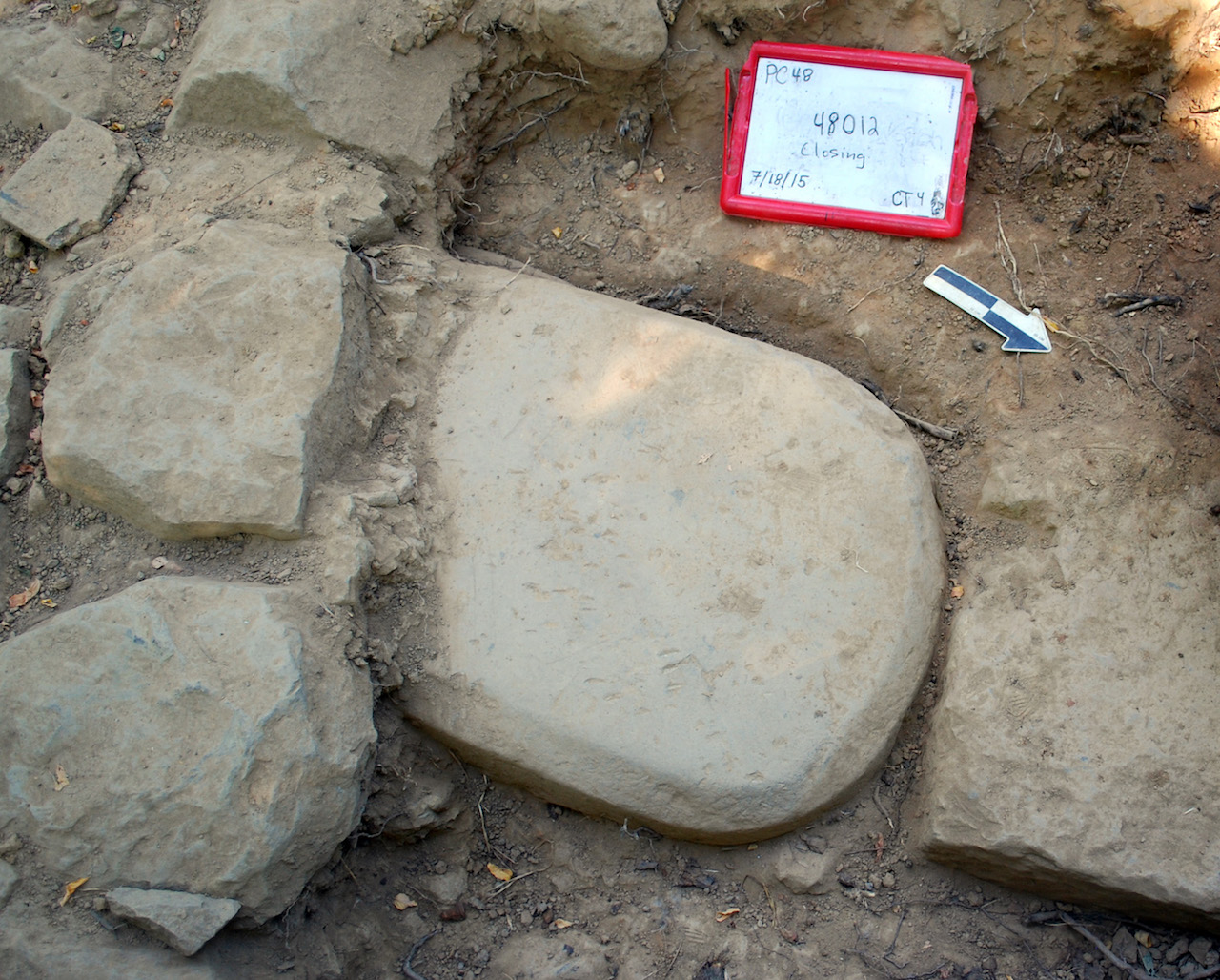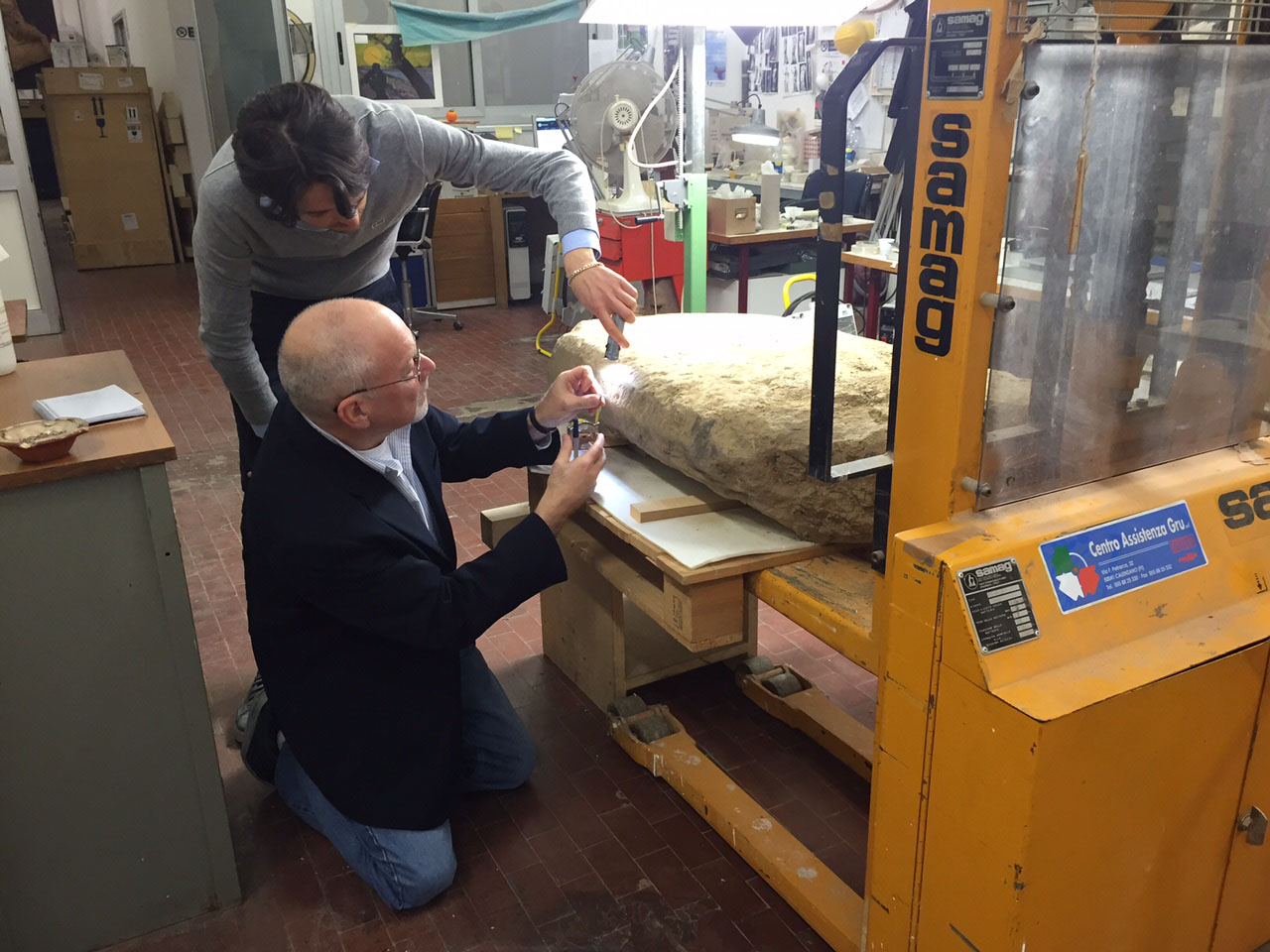Α)Unearthed Inscription May Unlock Mysteries of the Etruscan Language
 The few examples of Etruscan language that survive tell more about the dead than the everyday lives of the living, being mostly eulogies in tombs of the elite. The longest known text — and the only linen work to make it to the modern age — is a calendar reused in the binding of
an Egyptian mummy. So the recent discovery of a four-foot high,
500-pound sandstone stele at Poggio Colla northeast of Florence that has
around 70 legible letters and punctuation marks is huge for the study of this ancient civilization.
The few examples of Etruscan language that survive tell more about the dead than the everyday lives of the living, being mostly eulogies in tombs of the elite. The longest known text — and the only linen work to make it to the modern age — is a calendar reused in the binding of
an Egyptian mummy. So the recent discovery of a four-foot high,
500-pound sandstone stele at Poggio Colla northeast of Florence that has
around 70 legible letters and punctuation marks is huge for the study of this ancient civilization.

Southern Methodist University (SMU), the main sponsor of the Mugello Valley Archaeological Project which unearthed the stone in the foundation of a temple, announced the find this week. Jean MacIntosh Turfa, an Etruscan scholar with the University of Pennsylvania Museum, stated in the release that “[i]nscriptions of more than a few words, on permanent materials, are rare for the Etruscans, who tended to use perishable media like linen cloth books or wax tablets.”
Over the coming months, according to SMU, researchers with the University of Florence will be examining and conserving the sixth century BCE stone, using laser scanning and photogrammetry to gain a better view of the inscription. Being that it was found at a temple, salvaged for its foundation some 2,500 years ago, it’s likely the writing may relate to religion, potentially filling in gaps in historic knowledge of Etruscan practices.
Theresa Huntsman of Washington University writes for the Metropolitan Museum of Art that there “are no known parent languages to Etruscan, nor are there any modern descendants, as Latin gradually replaced it, along with other Italic languages, as the Romans gradually took control of the Italian peninsula.” In other words, deciphering Etruscan can still be difficult, as no literature or major written work still exists, and although it shares characteristics with the Greek alphabet, it was distinct. For example, text was written from right to left (although early Greek was written this way). Larissa Bonfante notes in Etruscan Life and Afterlife that “[w]hat we know most about, their monuments, has to be ‘read’ in order to gain information about their history, their religion, their daily life.”
Roman emperor Claudius is known to have compiled a compendium of 20 books on Etruscan history that are now lost, and fascinating objects like the 2nd century BCE “Liver of Piacenza,” a bronze of a sheep’s liver etched with Etruscan writing, have offered fleeting glimpses of this obscured past. The stele may broaden our knowledge of this lost language, which remains one of the ancient world’s great enigmas.
 h/t Ars Technica
h/t Ars Technica
Read more about the Etruscan stele discovery by the Mugello Valley Archaeological Project at Southern Methodist University.
 Credit: The Gebel el Silsila Project 2016.
In the last two years, archaeologists have made quite a few fascinating discoveries over at Gebel el Silsila (also known as Kheny or ‘Rowing Place’ in Egyptian), the famed ancient sandstone quarries of Egypt, north of Aswan. These findings entailed: stone carvings of an Egyptian pharaoh (who was depicted making offerings two major Egyptian gods Amun-Ra and Thoth) and a four-storied temple (with 6,900 sq ft foundation area). Simply put, the discoveries pretty much alluded to the plausible scenario that Kheny
was not just a stone quarry site, but also a proper settlement with its
own set of religious structures. And now the hypothesis can be
strengthened into a fact, with the recent excavation of an entire
necropolis at this Egyptian quarry site that dates from 3,400 years ago.
Credit: The Gebel el Silsila Project 2016.
In the last two years, archaeologists have made quite a few fascinating discoveries over at Gebel el Silsila (also known as Kheny or ‘Rowing Place’ in Egyptian), the famed ancient sandstone quarries of Egypt, north of Aswan. These findings entailed: stone carvings of an Egyptian pharaoh (who was depicted making offerings two major Egyptian gods Amun-Ra and Thoth) and a four-storied temple (with 6,900 sq ft foundation area). Simply put, the discoveries pretty much alluded to the plausible scenario that Kheny
was not just a stone quarry site, but also a proper settlement with its
own set of religious structures. And now the hypothesis can be
strengthened into a fact, with the recent excavation of an entire
necropolis at this Egyptian quarry site that dates from 3,400 years ago.
Contemporary to the New Kingdom period, the necropolis was surveyed and found to have over 40 tombs, while being flanked by small shrine by the banks of Nile. Unfortunately, as noted by Lund University researchers (the same researchers who made the initial discovery of the Pharaoh carving in 2014), many of these burial compartments are dilapidated due to effects of heavy erosion and decay brought on by the rising levels and high salt-content of the Nile water.
Now structurally, the necropolis was (conventionally) situated at a below-ground level with its main access being furnished from a series of steps that led to roughly-planned square chamber. Suffice it to say, the tomb entrances open to this courtyard-like chamber, while also comprising square apertures that have vertical slots to either door – possibly for vertically arranged lids. As for the aforementioned shrine, the rock-cut structure has a pair of open-chambers that look out to the river, along with an interior doorway that proudly showcases the winged solar disc.
Now it should be noted that while Gebel el Silsila was a thriving economic site (especially given its importance as a stone quarry) most of the higher-ranked officials stationed here were buried at Thebes. So the necropolis in Kheny probably catered to people who were slightly down the social ladder. The unadorned nature of the tombs pretty much mirrored such an economic status. However, on the other hand, the researchers are also quite sure that the occupants were more like middle-class, as opposed to poor laborers and workers. This is evident from finds such as fragments of painted mud-plaster (that were possibly used for decorative coffins), along with mummy wrappings and objects like beads and amulets.
Other related discoveries included a reversible seal ring with the Egyptian trademark design of a cartouche (consisting of an oval circle) and a scarab – both depicting Pharaoh Thuthmosis III Men-kheper-re. These are complemented by other funeral-oriented artifacts, like storage vessels, beer jugs and candle containers. John Ward, associate director of the excavation project, made it clear –

The
Etruscan stele discovered in the foundations of a monumental temple,
where it had been for over 2,500 years (courtesy Mugello Valley Project)
Southern Methodist University (SMU), the main sponsor of the Mugello Valley Archaeological Project which unearthed the stone in the foundation of a temple, announced the find this week. Jean MacIntosh Turfa, an Etruscan scholar with the University of Pennsylvania Museum, stated in the release that “[i]nscriptions of more than a few words, on permanent materials, are rare for the Etruscans, who tended to use perishable media like linen cloth books or wax tablets.”
Over the coming months, according to SMU, researchers with the University of Florence will be examining and conserving the sixth century BCE stone, using laser scanning and photogrammetry to gain a better view of the inscription. Being that it was found at a temple, salvaged for its foundation some 2,500 years ago, it’s likely the writing may relate to religion, potentially filling in gaps in historic knowledge of Etruscan practices.
Theresa Huntsman of Washington University writes for the Metropolitan Museum of Art that there “are no known parent languages to Etruscan, nor are there any modern descendants, as Latin gradually replaced it, along with other Italic languages, as the Romans gradually took control of the Italian peninsula.” In other words, deciphering Etruscan can still be difficult, as no literature or major written work still exists, and although it shares characteristics with the Greek alphabet, it was distinct. For example, text was written from right to left (although early Greek was written this way). Larissa Bonfante notes in Etruscan Life and Afterlife that “[w]hat we know most about, their monuments, has to be ‘read’ in order to gain information about their history, their religion, their daily life.”
Roman emperor Claudius is known to have compiled a compendium of 20 books on Etruscan history that are now lost, and fascinating objects like the 2nd century BCE “Liver of Piacenza,” a bronze of a sheep’s liver etched with Etruscan writing, have offered fleeting glimpses of this obscured past. The stele may broaden our knowledge of this lost language, which remains one of the ancient world’s great enigmas.

Scientists examining the Etruscan stele (courtesy Mugello Valley Project)
Read more about the Etruscan stele discovery by the Mugello Valley Archaeological Project at Southern Methodist University.
====================================
Β)3,400-year old Egyptian necropolis discovered at Gebel el Silsila, the famed stone quarry
 Credit: The Gebel el Silsila Project 2016.
Credit: The Gebel el Silsila Project 2016.Contemporary to the New Kingdom period, the necropolis was surveyed and found to have over 40 tombs, while being flanked by small shrine by the banks of Nile. Unfortunately, as noted by Lund University researchers (the same researchers who made the initial discovery of the Pharaoh carving in 2014), many of these burial compartments are dilapidated due to effects of heavy erosion and decay brought on by the rising levels and high salt-content of the Nile water.
Now structurally, the necropolis was (conventionally) situated at a below-ground level with its main access being furnished from a series of steps that led to roughly-planned square chamber. Suffice it to say, the tomb entrances open to this courtyard-like chamber, while also comprising square apertures that have vertical slots to either door – possibly for vertically arranged lids. As for the aforementioned shrine, the rock-cut structure has a pair of open-chambers that look out to the river, along with an interior doorway that proudly showcases the winged solar disc.
Now it should be noted that while Gebel el Silsila was a thriving economic site (especially given its importance as a stone quarry) most of the higher-ranked officials stationed here were buried at Thebes. So the necropolis in Kheny probably catered to people who were slightly down the social ladder. The unadorned nature of the tombs pretty much mirrored such an economic status. However, on the other hand, the researchers are also quite sure that the occupants were more like middle-class, as opposed to poor laborers and workers. This is evident from finds such as fragments of painted mud-plaster (that were possibly used for decorative coffins), along with mummy wrappings and objects like beads and amulets.
Other related discoveries included a reversible seal ring with the Egyptian trademark design of a cartouche (consisting of an oval circle) and a scarab – both depicting Pharaoh Thuthmosis III Men-kheper-re. These are complemented by other funeral-oriented artifacts, like storage vessels, beer jugs and candle containers. John Ward, associate director of the excavation project, made it clear –
Preliminary analysis of the bones suggests burials of men, women and children of all ages. Importantly, this indicates a more permanent habitation at Gebel el Silsila than previously thought.Via: AtlasObscura


Δεν υπάρχουν σχόλια:
Δημοσίευση σχολίου